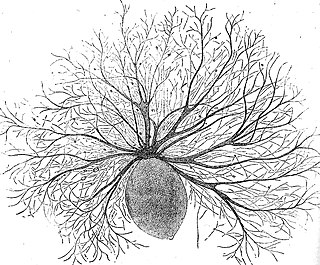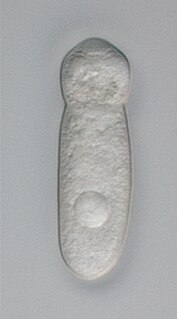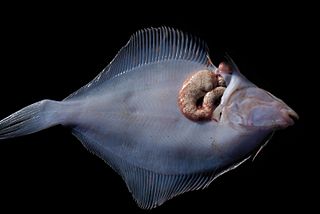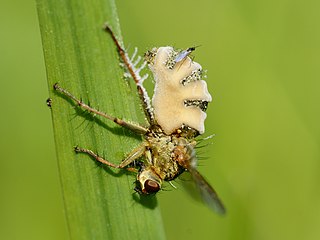Related Research Articles

The Apicomplexa are a large phylum of parasitic alveolates. Most of them possess a unique form of organelle that comprises a type of non-photosynthetic plastid called an apicoplast, and an apical complex structure. The organelle is an adaptation that the apicomplexan applies in penetration of a host cell.

Copepods are a group of small crustaceans found in nearly every freshwater and saltwater habitat. Some species are planktonic, some are benthic, a number of species have parasitic phases, and some continental species may live in limnoterrestrial habitats and other wet terrestrial places, such as swamps, under leaf fall in wet forests, bogs, springs, ephemeral ponds, and puddles, damp moss, or water-filled recesses (phytotelmata) of plants such as bromeliads and pitcher plants. Many live underground in marine and freshwater caves, sinkholes, or stream beds. Copepods are sometimes used as biodiversity indicators.
Perkinsus marinus is a species of alveolates belonging to the phylum Perkinsozoa. It is similar to a dinoflagellate. It is known as a prevalent pathogen of oysters, causing massive mortality in oyster populations. The disease it causes is known as dermo or perkinsosis, and is characterized by the degradation of oyster tissues. The genome of this species has been sequenced.

Velvet disease is a fish disease caused by dinoflagellate parasites of the genus Piscinoodinium, specifically Amyloodinium in marine fish, and Oodinium in freshwater fish. The disease gives infected organisms a dusty, brownish-gold color. The disease occurs most commonly in tropical fish, and to a lesser extent, marine aquaria.

The gregarines are a group of Apicomplexan alveolates, classified as the Gregarinasina or Gregarinia. The large parasites inhabit the intestines of many invertebrates. They are not found in any vertebrates. However, gregarines are closely related to both Toxoplasma and Plasmodium, which cause toxoplasmosis and malaria, respectively. Both protists use protein complexes similar to those that are formed by the gregarines for gliding motility and invading target cells. This makes them excellent models for studying gliding motility with the goal of developing treatment options for toxoplasmosis and malaria. Thousands of different species of gregarines are expected to be found in insects, and 99% of these gregarines still need to be described. Each insect can be the host of multiple species. One of the most studied gregarines is Gregarina garnhami. In general, gregarines are regarded as very successful parasites, as their hosts are spread over the entire planet.
Sparganosis is a parasitic infection caused by the plerocercoid larvae of the genus Spirometra including S. mansoni, S. ranarum, S. mansonoides and S. erinacei. It was first described by Patrick Manson from China in 1882, and the first human case was reported by Charles Wardell Stiles from Florida in 1908. The infection is transmitted by ingestion of contaminated water, ingestion of a second intermediate host such as a frog or snake, or contact between a second intermediate host and an open wound or mucous membrane. Humans are the accidental hosts in the life cycle, while dogs, cats, and other mammals are definitive hosts. Copepods are the first intermediate hosts, and various amphibians and reptiles are second intermediate hosts.

A xenoma is a growth caused by various protists and fungi, most notably microsporidia. It can occur on numerous organisms; however is predominantly found on fish.

Entomophthora is a fungal genus in the family Entomophthoraceae. Species in this genus are parasitic on flies and other two-winged insects. The genus was circumscribed by German biologist Ferdinand Cohn in 1856.

Like humans and other animals, fish suffer from diseases and parasites. Fish defences against disease are specific and non-specific. Non-specific defences include skin and scales, as well as the mucus layer secreted by the epidermis that traps microorganisms and inhibits their growth. If pathogens breach these defences, fish can develop inflammatory responses that increase the flow of blood to infected areas and deliver white blood cells that attempt to destroy the pathogens.
Syndinium is a cosmopolitan genus of parasitic dinoflagellates that infest and kill marine planktonic species of copepods and radiolarians. Syndinium belongs to order Syndiniales, a candidate for the uncultured group I and II marine alveolates. The lifecycle of Syndinium is not well understood beyond the parasitic and zoospore stages.
Hematodinium is a genus of dinoflagellates. Species in this genus, such as Hematodinium perezi, the type species, are internal parasites of the hemolymph of crustaceans such as the Atlantic blue crab and Norway lobster. Species in the genus are economically damaging to commercial crab fisheries, including causing bitter crab disease in the large Tanner or snow crab fisheries of the Bering Sea.
Parvilucifera is a genus of marine alveolates that parasitise dinoflagellates. Parvilucifera is a parasitic genus described in 1999 by Norén et al. It is classified perkinsozoa in the supraphylum of Alveolates. This taxon serves as a sister taxon to the dinoflagellates and apicomplexans. Thus far, five species have been described in this taxon, which include: P.infectans, P.sinerae, P.corolla, P.rostrata, and P.prorocentri. The genus Parvilucifera is morphologically characterized by flagellated zoospore. The life cycle of the species in this genus consist of free-living zoospores, an intracellular stage called trophont, and asexual division to form resting sporangium inside host cell. This taxon has gained more interest in research due to its potential significance in terms of negative regulation for dinoflagellates blooms, that have proved harmful for algal species, humans, and the shellfish industry.
Pasteuria is a genus of mycelial and endospore-forming, nonmotile gram-positive bacteria that are obligate parasites of some nematodes and crustaceans. The genus of Pasteuria was previously classified within the family Alicyclobacillaceae, but has since been moved to the family Pasteuriaceae.
Physoderma is a genus of chytrid fungi. Described by German botanist Karl Friedrich Wilhelm Wallroth in 1833, the genus contains some species that are parasitic on vascular plants, including P. alfalfae and P. maydis, causative agents of crown wart of alfalfa and brown spot of corn, respectively. Of the chytrid genera, Physoderma is the oldest. However, species were confused with the rust fungi, the genus Synchytrium, and the genus Protomyces of Ascomycota. Members of Physoderma are obligate parasites of pteridophytes and angiosperms. There are approximately 80 species within this genus.
Amyloodinium ocellatum is a cosmopolitan ectoparasite dinoflagellate of numerous aquatic organisms living in brackish and seawater environments. The dinoflagellate is endemic in temperate and tropical areas, and is capable of successfully adapting to a variety of different environments and to a great number of hosts, having been identified in four phyla of aquatic organisms: Chordata, Arthropoda, Mollusca and Platyhelminthes. Moreover, it is the only dinoflagellate capable of infecting teleosts and elasmobranchs.
Blastodinium is a diverse genus of dinoflagellates and important parasites of planktonic copepods. They exist in either a parasitic stage, a trophont stage, and a dinospore stage. Although morphologically and functionally diverse, as parasites they live exclusively in the intestinal tract of copeods.
Coccidinium is a genus of parasitic syndinian dinoflagellates that infect the nucleus and cytoplasm of other marine dinoflagellates. Coccidinium, along with two other dinoflagellate genera, Amoebophyra and Duboscquella, contain species that are the primary endoparasites of marine dinoflagellates. While numerous studies have been conducted on the genus Amoebophyra, specifically Amoebophyra ceratii, little is known about Coccidinium. These microscopic organisms have gone relatively unstudied after the initial observations of Édouard Chatton and Berthe Biecheler in 1934 and 1936.
Ichthyodinium is a monotypic genus of dinoflagellates in the family Dinophysaceae. Ichthyodinium chabelardi (/ɪkθioʊˈdɪniəm/) is currently the sole described species of the genus.

Haplozoon (/hæploʊ’zoʊən/) are unicellular endo-parasites, primarily infecting maldanid polychaetes. They belong to Dinoflagellata but differ from typical dinoflagellates. Most dinoflagellates are free-living and possess two flagella. Instead, Haplozoon belong to a 5% minority of parasitic dinoflagellates that are not free-living. Additionally, the Haplozoon trophont stage is particularly unique due to an apparent lack of flagella. The presence of flagella or remnant structures is the subject of ongoing research.
Nectonema is a genus of marine horsehair worms first described by Addison E. Verrill in 1879. It is the only genus in the family Nectonematidae described by Henry B. Ward in 1892, in the order Nectonematoidea, and in the class Nectonematoida. The genus contains five species; all species have a parasitic larval stage inhabiting crustacean hosts and a free-living adult stage that swims in open water.
References
- ↑ Gómez F, López-García P, Nowaczyk A, Moreira D (2009). "The crustacean parasites Ellobiopsis Caullery, 1910 and Thalassomyces Niezabitowski, 1913 form a monophyletic divergent clade within the Alveolata". Syst. Parasitol. 74 (1): 65–74. doi:10.1007/s11230-009-9199-1. PMID 19633933. S2CID 3901878.
- 1 2 3 4 5 Shields, Jeffrey D. (1994). "The parasitic dinoflagellates of marine crustaceans". Annual Review of Fish Diseases. 4: 241–271. CiteSeerX 10.1.1.520.1367 . doi:10.1016/0959-8030(94)90031-0.
- ↑ Albaina, A.; Irigoien, X. (2006-04-01). "Fecundity limitation of Calanus helgolandicus, by the parasite Ellobiopsis sp". Journal of Plankton Research. 28 (4): 413–418. doi: 10.1093/plankt/fbi129 . ISSN 0142-7873.
- 1 2 3 Gómez, Fernando; López-García, Purificación; Nowaczyk, Antoine; Moreira, David (September 2009). "The crustacean parasites Ellobiopsis Caullery, 1910 and Thalassomyces Niezabitowski, 1913 form a monophyletic divergent clade within the Alveolata". Systematic Parasitology. 74 (1): 65–74. doi:10.1007/s11230-009-9199-1. ISSN 1573-5192. PMID 19633933. S2CID 3901878.
- 1 2 3 V., Santhakumari; M., Saraswathy (1979). "On the ellobiopsidae, parasitic protozoa from zooplankton". Mahasagar: Bulletin of the National Institute of Oceanography, India. ISSN 0542-0938.